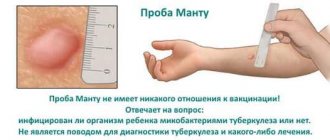The first administration of the BCG vaccine is given to the child in the maternity hospital, just a few days after his birth.
The purpose of vaccination is to create a protective barrier to the development of tuberculosis. Often, after this procedure, parents note that the BCG vaccination has festered.
Such changes are not considered by doctors as a disease. This is a normal reaction of the body, but it should not be underestimated. The injection site must be constantly monitored.
What is the BCG vaccination?
BCG is a foreign abbreviation that stands for BCG - Bacillus Calmette (Bacillus Calmette-Guerin). Vaccination is included in the list of mandatory vaccinations, but not everyone has an idea of what this drug is and what the purpose of its administration is.
The medication is designed to protect a person from tuberculosis. To make the drug, a live but very weakened strain of tuberculosis bacillus is used. It is not dangerous for the child, as it is grown in an artificial environment.
Among the main features of the vaccine are the following:
- used to prevent tuberculosis;
- is not intended to protect against infection, the infection in vaccinated people occurs in a latent form, protection is created for the disease to become open;
- prevents tuberculosis from becoming severe, when bones and joints are damaged, dangerous forms of infection of the lungs, tuberculous meningitis;
- helps reduce the incidence of morbidity in childhood.
Norm and deviations
What to do if the graft site begins to fester and is this a problem? In fact, such a reaction is normal; the appearance of a small wound indicates that the body is undergoing a period of formation of immunity to the introduced mycobacterium. The norm is the appearance of a small abscess up to one centimeter in size without severe complications such as inflammation of tissues and lymph nodes, elevated temperature.
Normal reaction
Also considered normal
If the size of the ulcer is more than one centimeter, then this is a sign of increased sensitivity of the body to the vaccine or the presence of immunodeficiency in the child. Regardless of the cause, you should consult a doctor for further monitoring.
Deviations
Also considered a deviation from the norm
Normally, the formation of immunity occurs in three stages:
- at the site of vaccination, redness of the tissues and their thickening are observed, this takes about 1-2 months;
- a small bubble with a whitish head appears, which becomes covered with a crust - it is at this time that the body’s local fight against mycobacteria occurs, and pus is the decay products of dead bacteria and lymphocytes;
- Scarring occurs, which indicates the development of immunity; in some cases, such a scar may be absent altogether, but this indicates unformed immunity or too deep administration of the vaccine.
BCG is festering: is this normal?
An abscess that appears at the site of BCG in newborns is considered normal.
The introduction of the vaccine leads to the following changes:
- A white spot appears on the skin, which disappears after half an hour.
- The vaccination site turns red and swells. Similar symptoms are observed within three days.
- No reactions have been observed for a month.
- A month after vaccination, a papule appears, which transforms into an abscess.
The reaction to the vaccine in infants manifests itself slowly . The immune response is observed after one or two months. During this period, BCG begins to fester. Such changes are considered normal. The body reacts to the introduction of a foreign body under the skin.
The following external signs of abscess formation are noted:
- a formation shaped like a pimple, capsule or spot that protrudes above the skin;
- the size of the abscess reaches one centimeter;
- the injection site becomes bluish, brown, red or flesh-colored, and the presence of purulent contents is noted.
After a while, the contents of the abscess flow out, a crust forms, which disappears on its own. After six months, only a scar remains in place of the BCG.
What exactly causes pus to appear?
Rotting after BCG vaccination in a child at 2 months is a natural reaction to the vaccine. Such changes are not a cause for concern if the abscess is small and the accompanying symptoms are consistent. Sometimes an immune response is observed in the form of redness without pus, which is also considered normal.
This is how the reaction to the strain of infection that has entered the body is manifested. The syringe is inserted intradermally. This leads to inevitable dermatological changes.
Sometimes such symptoms are regarded as manifestations of BCG infection. This is a serious complication of vaccination, but it is worse when the wound does not fester. The vaccine does not have the desired effect.
Suppuration is caused by improper administration of the drug. This occurs if the vaccine was given subcutaneously, and not intradermally, as required by the instructions. In addition, unpleasant symptoms are observed when using a low-quality vaccine.
Rules for administering the vaccine and normal reaction, photo
The site of administration of the active substance of the WHO vaccine is recommended to choose the outer side of the left forearm at the boundary of the second and third third. In the Russian Federation, BCG is administered exactly this way - into the shoulder. The injection must be done inside the skin. Under no circumstances should the drug be administered subcutaneously or intramuscularly. If there are any reasons not to inject the drug into the forearm, choose another injection site where there is thick skin. Usually this is the surface of the thigh.
Where are vaccinations given:
Newborn children in the maternity hospital.
If not done in the maternity hospital, then in the children's clinic at the place of residence. At the same time, there are clear rules for vaccination in a clinic setting. These should be either two vaccination rooms (separate for BCG), or one (then a separate day is allocated for BCG). It is strictly forbidden to carry out BCG vaccination in the treatment room where tests are taken. All this is spelled out in the SanPin rules.
For children at high risk of a severe reaction to the vaccine, it is given only in a tuberculosis clinic.
Vaccination at home. This procedure is permitted by law. A specialized team visits your home for a fee.
In other special centers where there is an appropriate license.
There are certain rules for vaccination with this vaccine. It uses only a disposable syringe with a thin needle and a beveled tip. The injection technique is very important: first, stretch the skin area and inject half of the injection to determine that the needle has entered exactly intradermally. Once this is confirmed, the entire vaccine is administered.
When the drug is administered correctly, a whitish papule with a diameter of 5-10 mm is formed on the surface. The papule persists for 15-20 minutes and disappears. This is called a specific reaction to the BCG vaccine and is considered normal. In newborn babies, a month or two after vaccination, a normal reaction begins, lasting up to 90 days. When children are revaccinated at seven years of age, the reaction to the vaccine begins 7-14 days after administration.
The injection site with a post-vaccination reaction must be protected, avoiding excessive external influence - rubbing, scratching, do not rub with a washcloth. If water gets in, it's okay.
The post-vaccination reaction consists of the formation of a papule at the injection site. The injection site may fester and burst. Then this formation is transformed back into a two-month period. A gradually healing crust forms on the wound. When the wound heals, the crust will fall off, leaving a small scar with a diameter of up to 1 cm on the skin.
The absence of a scar indicates a violation of the vaccination technology and the lack of effect from the vaccination.
The graft site may become red and swollen, but the redness may not extend to the tissue around the graft.
Some parents are frightened by the formation of an abscess in the infant at the injection site. They think that something went wrong, and if the BCG vaccine in an infant festered, then this is a serious complication. However, it is not. A small abscess is normal. It should be remembered that it takes months to heal completely, namely after about four months. If the BCG vaccination has rotted, then what should you do? How to treat the injection site? The child’s routine at this time is not disrupted in any way. Under no circumstances should you apply antibacterial or antiseptic ointments to the area, much less use peroxide, so as not to interfere with the effect of the vaccine. You can carefully wash off the pus with water and blot lightly with a sterile gauze pad.
Another private question: pus came out of the BCG vaccination, what should I do about it?
The abscess can sometimes burst and break through with pus flowing out. Then the inflammatory contents can still form for some time, easily come out of the wound or form an abscess again. Pus should not be squeezed out. This can result in serious complications.
What if pus does not come out of the BCG vaccination? In some children, suppuration does not occur. Both options are considered normal and do not require any treatment, even if the BCG vaccination suddenly breaks through.
After BCG, a low temperature sometimes appears, but this is a rather rare occurrence. The purulent process is also sometimes accompanied by a temperature of no higher than 37 degrees. If a seven-year-old child develops a fever after BCG vaccination, you should consult a pediatrician.
When suppuration is not normal
Not in all cases the appearance of an abscess is considered normal. It should not exceed 1.5–2 cm in size.
The following changes are also of concern:
- pink or red halo;
- there is severe swelling around the abscess;
- ulcers form at the injection site;
- the appearance of a keloid scar is noted;
- axillary lymph nodes are enlarged.
If such symptoms appear, you should consult a doctor. Secondary infection and complications of vaccination cannot be ruled out.
Individual intolerance
There are cases when a child after a BCG vaccination begins to feel unwell. Most often, the cause of this condition is an individual reaction to the administered drug or its components. Symptoms of this phenomenon may include:
- Severe weakness, lethargy, apathy.
- Loss of appetite.
- Sleep disturbance.
- A sharp increase in temperature.
- Headache.
- Joint pain.
- Severe allergic reaction.
- Hyperemia of the injection site and surrounding area.
- Swelling over 3 cm.
In particular, this is why doctors recommend staying close to the clinic at least during the first half hour. As a rule, with individual intolerance, symptoms appear immediately.
If your baby exhibits any of the above symptoms after vaccination, you should definitely consult a doctor for advice. Firstly, a note will be made in the child’s card, secondly, the baby will be given first aid and, if necessary, treatment will be prescribed, thirdly, these symptoms are not always the result of intolerance, it is possible that the child’s vaccination coincided with the onset of a cold diseases, for example.
Is it possible to squeeze pus out of a vaccine?
It is strictly forbidden to perform the following manipulations with the abscess:
- open, cut and pierce;
- picking, combing and squeezing;
- cover with a plaster and bandage;
- rub, press.
It is extremely important that the pus drains on its own. If the size of the abscess exceeds the permissible norms, and the skin around it becomes inflamed, you need to contact a medical facility. The doctor will open the purulent formation and prescribe proper treatment.
You cannot try to help the baby on your own and resort to pumping out pus. Such actions can lead to its accumulation in other places and the addition of a secondary infection.
Possible complications
The appearance of an abscess is considered a natural physiological process after BCG vaccination. It disappears on its own. No drastic measures need to be taken.
You should also not ignore purulent formation . He needs to be monitored and hygiene rules observed. It is unacceptable for dirt to get into the wound. Mechanical damage will also negatively affect the papule.
In the post-vaccination period, complications may occur. The doctor identifies the cause of such changes and then announces the prognosis.
The following pathological processes are observed:
- an increase in the size of the lymph nodes;
- addition of a secondary infection;
- formation of a red scar;
- statements;
- disseminated or persistent BCG infection;
- suppression of the immune system.
The pediatrician will be able to determine what is causing the abscess. Concomitant symptoms help to easily distinguish a local reaction to the vaccine from secondary infection and complications after immunization.
Contraindications to the vaccine
The development of various kinds of complications may be the result of contraindications in the child.
- low baby weight;
- intrauterine infection with pathogenic microorganisms;
- diagnosis of HIV infection in the mother;
- immunodeficiencies of various etiologies;
- diseases of the central nervous system;
- the presence of inflammatory processes in the body;
- active stage of the disease after diagnosis using x-ray photos.
These contraindications are absolute. If they are present, the BCG vaccine is completely prohibited. Vaccination will not provide complete protection against tuberculosis, but it can help develop immune defenses against bacterial agents.
The duration of the drug is on average 7 years. After this period has expired, revaccination must be carried out. Before this, a mandatory Mantoux test is performed.
Before administering the BCG vaccine, you must undergo a full examination by specialized doctors. This will help reduce the likelihood of complications and also protect the child’s health.









